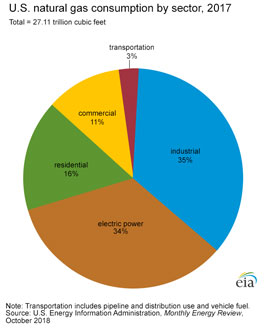The United States used about 27 trillion cubic feet (Tcf) of natural gas in 2017, the equivalent of 28 quadrillion British thermal units (Btu) and 29% of total U.S. primary energy consumption.
Natural gas use by U.S. consuming sectors by amount and share of total U.S. natural gas consumption in 2017
- Industrial—9.51 Tcf—35
- Electric power—9.25 Tcf—34%
- Residential—4.41 Tcf—16%
- Commercial—3.16 Tcf—12%
- Transportation—0.77 Tcf—3%
How natural gas is used in the United States
Most U.S. natural gas use is for heating buildings and generating electricity, but some consuming sectors have other uses for natural gas.
The industrial sector uses natural gas as a fuel for process heating, in combined heat and power systems, and as a raw material (feedstock) to produce chemicals, fertilizer, and hydrogen. In 2017, the industrial sector accounted for about 35% of U.S. natural gas consumption, and natural gas was the source of about 31% of the U.S. industrial sector's total energy consumption.
The electric power sector uses natural gas to generate electricity. In 2017, the electric power sector accounted for about 34% of U.S. natural gas consumption, and natural gas was the source of about 26% of the U.S. electric power sector's energy consumption. Most of the electricity produced by the electric power sector is sold to and used by the other U.S. consuming sectors, and that electricity use is included in each sector’s total energy consumption. The other consuming sectors also use natural gas to generate electricity, and nearly all of this electricity is used by the sectors themselves.
The residential sector uses natural gas to heat buildings and water, to cook, and to dry clothes. About half of the homes in the United States use natural gas for these purposes. In 2017, the residential sector accounted for about 16% of U.S. natural gas consumption, and natural gas was the source of about 23% of the U.S. residential sector's total energy consumption.
The commercial sector uses natural gas to heat buildings and water, to operate refrigeration and cooling equipment, to cook, to dry clothes, and to provide outdoor lighting. Some consumers in the commercial sector also use natural gas as a fuel in combined heat and power systems. In 2017, the commercial sector accounted for about 12% of U.S. natural gas consumption, and natural gas was the source of about 18% of the U.S. commercial sector's energy consumption.
The transportation sector uses natural gas as a fuel to operate compressors that move natural gas through pipelines and as a vehicle fuel in the form of compressed natural gas and liquefied natural gas. Nearly all vehicles that use natural gas as a fuel are in government and private vehicle fleets. In 2017, the transportation sector accounted for about 3% of total U.S. natural gas consumption. Natural gas was the source of about 3% of the U.S. transportation sector's energy consumption in 2017, of which 94% was for natural gas pipeline and distribution operations.
Where natural gas is used
Natural gas is used throughout the United States, but five states accounted for about 38% of total U.S. natural gas consumption in 2017:
- Texas—14.3%
- California—7.8%
- Louisiana—5.9%
- Florida—5.1%
- Pennsylvania—4.7%





